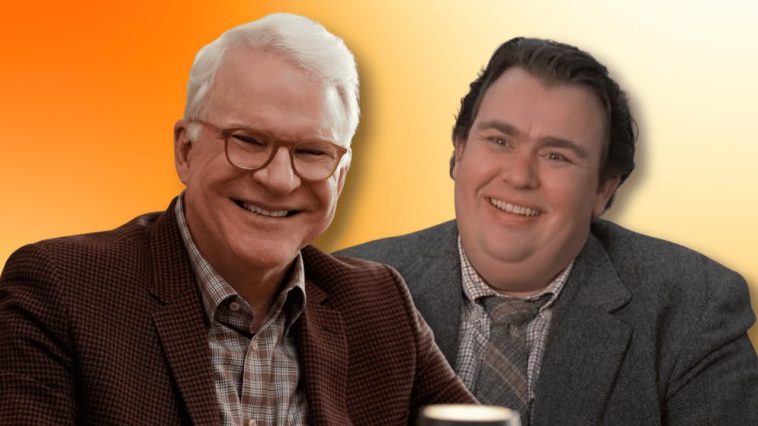In the vast expanse of Hollywood’s star-studded universe, there are few partnerships that have illuminated the big screen quite like the dynamic duo of Steve Martin and John Candy. Each a legend in their own right, Steve, known for his sharp wit in classics like “The Jerk” (1979) and “Father of the Bride” (1991), and Candy, celebrated for his heartwarming humor in unforgettable roles in “Planes, Trains & Automobiles” (1987) and “Uncle Buck” (1989), together they formed a cinematic match like no other.
Their on-screen antics have consistently left audiences in stitches, but beyond those comedic performances lies a genuine camaraderie woven together with mutual respect. Today, we pull back the veil to dive deep into the heartwarming bond these comedic giants shared off-screen. Through various interviews, Martin has been candid about the profound influence Candy had on him, both as a performer and a friend.
Timeless Collaborations
Additionally, as we revel in their timeless collaborations, we’ll journey behind the scenes of the iconic “Planes, Trains and Automobiles.” There’s so much more to this film than its legendary status suggests. We’ll unveil the lesser-known facts, stories, and inspirations that gave life to this comedy classic.
And while we bask in the warmth of their shared legacy, it’s crucial to also remember and honor the tragic day in 1994 when the world bid farewell to the incomparable John Candy.
So, sit back and join us on this cinematic journey, as we pay tribute to and unravel the enduring legacy, tales, and touching moments of Martin and Candy’s unparalleled collaborations.
Facts Verse Presents: Steve Martin Reveals His True Feelings About Working with John Candy
The Improv Escapades of Martin and Candy
Unscripted humor is an art form, allowing comedians to unshackle from the rigid structure of scripts and showcase their genuine comedic genius. Such was the atmosphere that the iconic John Hughes created for his actors, and “Uncle Buck” (1989) became a true testament to this freedom, allowing John Candy to unleash his comedic prowess.
However, it was during the filming of another Hughes classic, “Planes, Trains, and Automobiles” (1987), where the improvisational chemistry between Candy and Steve Martin became both legendary and, at times, problematic. The film follows the desperate journey of Neal Page, portrayed by Martin, who’s trying to make it home to Chicago for Thanksgiving. Circumstances push him together with Candy’s character, Del Griffith, an irritating yet endearing shower ring curtain salesman. As they stumble from one transportation disaster to another, the antics and humor never seem to end.
The very nature of the story opened doors for countless comedic moments. But when you combine the talents of Martin and Candy, what you get is pure, unfiltered hilarity. Their natural inclination was to deviate from the script, playing off each other’s wit, much to the chagrin of the camera crew.
A Comedic Gem
Despite the film being a comedic gem, not all was rosy behind the scenes. The chilly New York winter of 1987 brought with it challenges, especially when it came to their beloved improv. Shooting conditions became particularly difficult during exterior scenes, with Hughes opting for a one-shot shooting technique. This technique, though creative, became problematic when either Martin or Candy would go off-script, causing the crew to constantly adjust to capture the unplanned exchanges.
Reflecting on these challenging times, Martin once shared, “It was getting ridiculous, covering everything fifty times if we ad-libbed… All this ad-libbing was making the camera crew swing around us in the camera car again and again [to cover the shots]. Candy and I finally agreed not to ad-lib anymore.”
Nevertheless, through the biting cold and the unscripted challenges, one thing was clear: Martin and Candy truly enjoyed their time together on set. In fact, Martin would later go on to fondly refer to Candy as one of his best acting partners. Today, “Planes, Trains, and Automobiles” remains an enduring symbol of holiday spirit and gratitude, solidifying its place in cinematic history.
The Emotional Heartbeat Behind the Humor
“Planes, Trains and Automobiles” is more than just a comedy. Beyond the hilarious misadventures of a stranded marketing executive and an overbearing shower curtain ring salesman is a film that’s deeply rooted in emotion, relationships, and the complexity of human connections.
Year after year, families and fans gather to relive the memorable journey of these two mismatched characters, transforming the film into a cherished Thanksgiving tradition. Its humorous veneer is further enhanced by its subtle exploration of class dynamics, showcasing John Hughes’ prowess in weaving layered narratives.
Hughes’ Frequent Script
Yet, amidst the challenges of shooting on location, coupled with Hughes’ frequent script rewrites, the final film we came to love was birthed out of determination and sheer talent. Steve Martin and John Candy’s on-screen camaraderie was not just an act. Off the camera, their bond was palpable. Reflecting on his time with Candy, Martin once said, “We had a really good connection. When the camera was rolling, we’d look into each other’s eyes and it felt good together. We had great timing with each other.”
However, for all its comedic brilliance, there’s one scene that has left a lasting impact not just on audiences but particularly on Steve Martin. Nick de Semlyen, author of “Wild and Crazy Guys: How the Comedy Mavericks of the ’80s Changed Hollywood Forever,” highlighted this heart-wrenching scene where Candy’s character reveals the truth about his wife’s demise and his lack of a real home. This revelation cast a new light on his character’s behavior throughout the film, making audiences reevaluate the laughter-filled sequences they had watched.
The line that never fails to stir emotions, especially for Martin, was a testament to Candy’s improvisational prowess: “But this time I couldn’t let go.” This line, delivered with heartfelt sincerity, remains one of the most poignant scenes in cinematic history, showcasing John Candy’s versatility and depth as an actor.
Through Tragedy, A Bond Deepened
John Candy, with his larger-than-life personality and infectious laughter, was a beloved figure both on and off the screen. However, behind the cheerful facade, Candy grappled with health challenges that eventually culminated in his untimely demise. His sudden passing sent shockwaves throughout Hollywood and left countless fans heartbroken.
Beyond the realm of showbiz, the tragedy of Candy’s death resonated deeply with his close friend, Steve Martin. During a 2004 interview, Martin opened up about the turbulent period in his own life that coincided with Candy’s death. Amidst the throes of a painful divorce, Martin found himself seeking solace and distance from his tumultuous personal situation.
In a heartwarming gesture of solidarity and friendship, Martin briefly moved in with Candy’s widow and children. This wasn’t just an escape from his own challenges, but also an earnest effort to provide comfort and support to a grieving family. His presence undoubtedly brought some semblance of normalcy and warmth to a household reeling from an irreplaceable loss.
The act speaks volumes about the bond that existed between the two comedic giants. While their on-screen camaraderie was evident to audiences worldwide, the depth of their off-screen relationship became even more evident in the aftermath of tragedy. Through the toughest of times, Martin and Candy’s families leaned on each other, exemplifying the enduring power of friendship and shared grief.
More Behind-the-Scenes Secrets of “Planes, Trains and Automobiles”
Every iconic film often hides a treasure trove of stories that remain unknown to many. As we continue to dissect and analyze “Planes, Trains and Automobiles,” let’s journey into some of the lesser-known tidbits that helped shape this beloved classic.
The film’s premise, amusing as it is, was drawn from John Hughes’s own harrowing journey from New York City to Chicago. Before stepping into filmmaking, Hughes was a copywriter. A routine trip for a presentation turned into an odyssey filled with cancellations and unexpected detours. That trip, which stretched from a single day to nearly a week, served as the inspiration for the movie, with Hughes pouring his experience into the script with astounding speed, drafting the initial 60 pages in just six hours.
Though Hughes had previously collaborated with director Howard Deutch on classics like “Pretty in Pink” and “Some Kind of Wonderful,” he took the directorial reins himself for this project, especially after Steve Martin came on board. Interestingly, Martin initially found the 145-page script to be unusually lengthy for a comedy. And indeed, the first cut of the film was an epic four-and-a-half hours long!
Memorable Interaction
Behind the scenes, memorable moments were abundant. A memorable interaction between Martin and actress Edie McClurg, filled with colorful language, was so pivotal that it tipped the movie’s rating from PG-13 to R. And in a curious twist of Hollywood fate, a scene featuring future “Star Trek: Voyager” star Jeri Ryan was re-shot without her, despite her contagious laughter during a bus scene.
Adding to the movie’s rich tapestry of tales is the revelation that an Elton John song, penned specifically for this film, never saw the light of day due to a dispute over recording rights. And, in a touching nod to realism, Hughes’s choice of the film’s ending was influenced by a candid, unguarded moment of Martin laughing, which was captured without the actor’s knowledge.
In the end, whether it’s the tantalizing glimpse of a yet-to-be-released movie, “She’s Having a Baby,” in one scene or the intriguing stories of scenes shot but never shown, “Planes, Trains and Automobiles” remains a masterclass not just in storytelling, but in the rich tapestry of experiences that go into making a film truly unforgettable.
Undeniable Magic
As we come to the close of this video, it’s hard not to reflect on the undeniable magic of “Planes, Trains and Automobiles” and the remarkable collaboration of Steve Martin and John Candy. These two comedic giants, with their impeccable timing and heartfelt performances, have truly left an indelible mark on cinematic history. But now, we’d love to hear from you. What are your thoughts on this iconic film and the dynamic partnership of John and Steve? Do you have any favorite moments or memories tied to their collaborations? Drop your comments below. Thank you for joining us on this nostalgic journey, and as always, thank you for watching.



